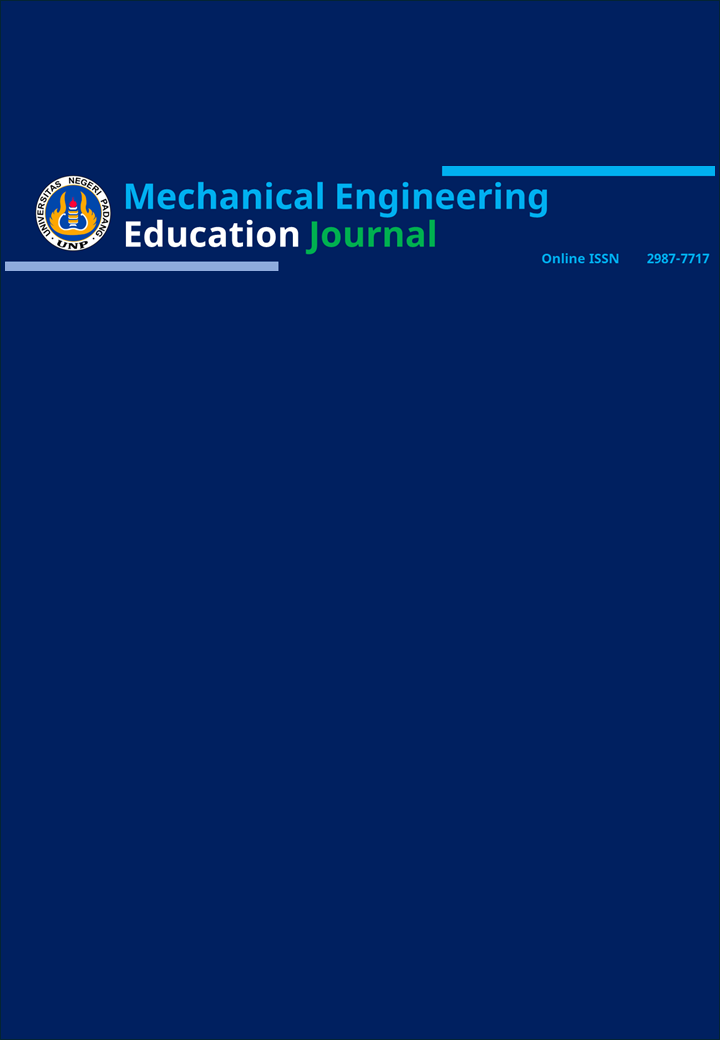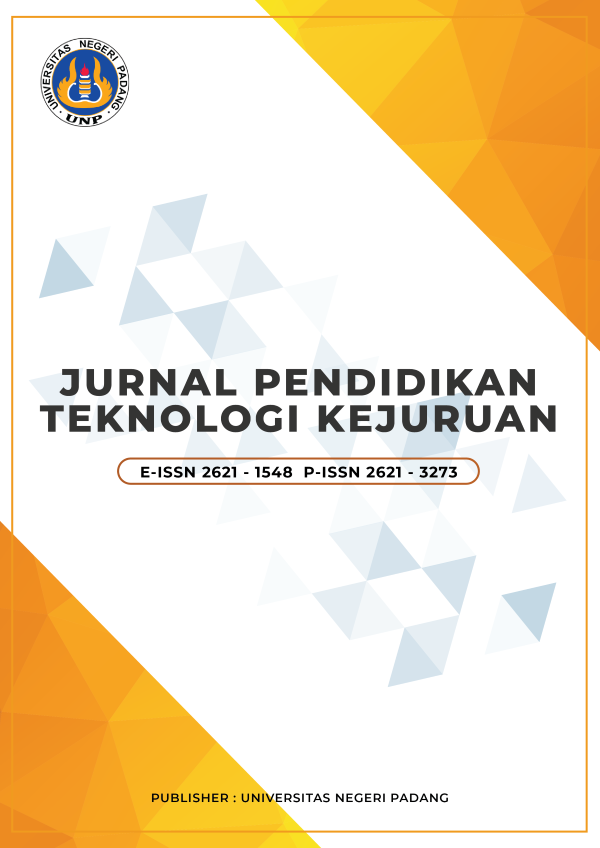Relationship between knowledge and students' welding practical skills
DOI:
https://doi.org/10.24036/meej.v1i2.28Keywords:
Theoretical Ability, Practical Skills, SMAW Welding, StudentsAbstract
This research aims to produce an understanding that explains the correlation between Theoretical Skills in Welding and the Results of SMAW Welding Practicum. The research method used is a quantitative method with a descriptive correlational approach, aimed at measuring the relationship between theoretical skills and practical skills. The research instruments used in this study include questionnaires, the results of practical exams, and documentation. The research was conducted at SMK Negeri 2 Payakumbuh, with a research population of 50 students in the eleventh grade of Welding Technology. The data analysis results show a significant and positive relationship between theoretical skills and practical results, with a correlation coefficient of 0.701 and a significance value (2-tailed) of 0.000. This indicates a significant and mutually influential relationship between theoretical skills and practical results. Based on the research findings, it can be concluded that the improvement of students' theoretical and practical skills can be utilized and implemented in SMAW welding education, leading to improved student learning outcomes and time efficiency in school. For the future, it is recommended that teachers pay more attention to the students' learning process, which is expected to have a positive impact on the enhancement of both theoretical and practical learning outcomes for students in the field of SMAW welding.
Downloads
References
Abass, O. A., Arowolo, O. A., & Igwe, E. N. (2020). Towards Enhancing Service Delivery in Higher Education Institutions via Knowledge Management Technologies and Blended E-Learning. International Journal on Studies in Education, 3(1), 10–21. https://doi.org/10.46328/ijonse.25
Adnani, Q. E. S., Gilkison, A., & McAra-Couper, J. (2022). A historical narrative of the development of midwifery education in Indonesia. Women and Birth, 1(February), 1–4. https://doi.org/10.1016/j.wombi.2022.06.007
Al-Barakat, A. A., Al-Hassan, O. M., AlAli, R. M., Al-Hassan, M. M., & Al sharief, R. A. (2023). Role of female teachers of childhood education in directing children towards effective use of smart devices. Education and Information Technologies, 28(6), 7065–7087. https://doi.org/10.1007/s10639-022-11481-y
Bloomfield, J., & Fisher, M. (2019). Quantitative research design. Journal of the Australasian Rehabilitation Nurses’ Association, 22(2), 27–30. https://doi.org/10.33235/JARNA.22.2.27-30
Eliaz, N. (2019). Corrosion of metallic biomaterials: A review. Materials, 12(3), 1–91. https://doi.org/10.3390/ma12030407
Fortuna, A., Rahmansyaf, I., Prasetya, F., Syaputra, W. Z., Rahmadhani, D., Saklaili, S., Bagus, M. I., Linda, E. S., Andriani, W., Muhammad, T., & Deria, A. (2023). Design of Prototype Model Augmented Reality-Based Disaster Mitigation Learning Media as a Disaster Education Facility. PAKAR Pendidikan, 21(1), 44–57. https://doi.org/https://doi.org/10.24036/pakar.v21i1.287 Aprilla
Furtasan Ali Yusuf, F., & Basrowi. (2023). The Effectiveness of the Internship Program for Vocational High School Students Using the CIPP Method. Jurnal Teknologi Pendidikan, 25(1), 15–28. https://doi.org/10.21009/jtp.v25i1.33553
Jabarullah, N. H., & Iqbal Hussain, H. (2019). The effectiveness of problem-based learning in technical and vocational education in Malaysia. Education and Training, 61(5), 552–567. https://doi.org/10.1108/ET-06-2018-0129
Lai, C. H., Wu, T. E., Huang, S. H., & Huang, Y. M. (2020). Developing a virtual learning tool for industrial high schools’ welding course. Procedia Computer Science, 172(2019), 696–700. https://doi.org/10.1016/j.procs.2020.05.091
Levrini, G. R. D., & Dos Santos, M. J. (2021). The influence of price on purchase intentions: Comparative study between cognitive, sensory, and neurophysiological experiments. Behavioral Sciences, 11(2), 1–16. https://doi.org/10.3390/bs11020016
Miller, E. C., & Krajcik, J. S. (2019). Promoting deep learning through project-based learning: a design problem. Disciplinary and Interdisciplinary Science Education Research, 1(1), 1–10. https://doi.org/10.1186/s43031-019-0009-6
Mueller, F., Deuerlein, C., & Koch, M. (2019). Intuitive Welding Robot Programming via Motion Capture and Augmented Reality. IFAC-PapersOnLine, 52(10), 294–299. https://doi.org/10.1016/j.ifacol.2019.10.045
Mustabsyiroh, N., Prestiadi, D., & Imron, A. (2021). Implementation of Virtual Academic Supervision as an Effort to Increase Teacher Competence in The Covid-19 Pandemic. Advances in Social Science, Education and Humanities Research, 589, 112–115.
Okolie, U. C., Nwajiuba, C. A., Binuomote, M. O., Ehiobuche, C., Igu, N. C. N., & Ajoke, O. S. (2020). Career training with mentoring programs in higher education: Facilitating career development and employability of graduates. Education and Training, 62(3), 214–234. https://doi.org/10.1108/ET-04-2019-0071/FULL/XML
Olaniyi, N. E. E. (2020). Threshold concepts: designing a format for the flipped classroom as an active learning technique for crossing the threshold. Research and Practice in Technology Enhanced Learning, 15(1), 1–15. https://doi.org/10.1186/s41039-020-0122-3
Prasetya, F., Fajri, B. R., Wulansari, R. E., Primawati, & Fortuna, A. (2023). Virtual Reality Adventures as an Effort to Improve the Quality of Welding Technology Learning During a Pandemic. International Journal of Online and Biomedical Engineering (IJOE), 19(2), 4–22. https://doi.org/10.3991/ijoe.v19i02.35447
Putra, A. B. N. R., Mukhadis, A., Ulfatin, N., Tuwoso, Subandi, M. S., Hardika, & Muhammad, A. K. (2021). The Innovation of Disruptive Learning Media with Augmented Reality Based 3D Object Concept with Drill Machine Design to Improve Quality of Distance Learning in The Era of Education 4.0. International Journal of Interactive Mobile Technologies (IJIM), 15(12), 193–200. https://doi.org/10.3991/ijim.v15i12.21579
Sinclair, D., Heap, A., Norris, K., Carey, R., Anderson, C., & Lea, E. (2023). End user perspectives on design and conduct of health-related disaster research. International Journal of Disaster Risk Reduction, 96(March), 103919. https://doi.org/10.1016/j.ijdrr.2023.103919
Sishchuk, J., Oblova, I., & Mikhailova, M. (2020). The Comparative Analysis of the United Kingdom and the Russian Federation Occupational Standard Development. In Lecture Notes in Networks and Systems (Vol. 131, Issue March). https://doi.org/10.1007/978-3-030-47415-7_86
Sriadhi, S., Hamid, A., & Restu, R. (2022). Web-Based Virtual Laboratory Development for Basic Practicums in Science and Technology. TEM Journal, 11(1), 396–402. https://doi.org/10.18421/TEM111-50
Xu, S., Wang, J., Shou, W., Ngo, T., Sadick, A. M., & Wang, X. (2021). Computer Vision Techniques in Construction: A Critical Review. Archives of Computational Methods in Engineering, 28(5), 3383–3397. https://doi.org/10.1007/s11831-020-09504-3
Yildiz, C., & Yildiz, T. G. (2021). Exploring the relationship between creative thinking and scientific process skills of preschool children. Thinking Skills and Creativity, 39(February), 100795. https://doi.org/10.1016/j.tsc.2021.100795
Downloads
Published
How to Cite
Issue
Section
License
Copyright (c) 2024 Rahim Fitra Yodi, Irzal Irzal, Adri Junil, Purwantono Purwantono

This work is licensed under a Creative Commons Attribution-ShareAlike 4.0 International License.
Most read articles by the same author(s)
- Indra Wita, Eko Indrawan, Irzal Irzal, Junil Adri, Primawati Primawati, Student's perceptions on choosing CAD software , Mechanical Engineering Education Journal: Vol. 1 No. 3 (2023): Regular Issue
- Jefri Aditia, Jasman Jasman, Irzal Irzal, Zainal Abadi, Relationship between the Implementation of Occupational Health and Safety and Practical Turning Learning Outcomes of Vocational High School Students , Mechanical Engineering Education Journal: Vol. 1 No. 2 (2023): Regular Issue
- Yang Yung Irawan, Yufrizal A, Purwantono Purwantono, Randi Purnama Putra, The Contribution of Workshop Management to Students' Learning Outcomes in Vocational High School , Mechanical Engineering Education Journal: Vol. 1 No. 1 (2023): Regular Issue
- Putra Khairus, Eko Indrawan, Junil Adri, Irzal Irzal, Analysis of job risk at machine workshop , Mechanical Engineering Education Journal: Vol. 1 No. 3 (2023): Regular Issue
- Arifin Adli, Ambiyar Ambiyar, Refdinal Refdinal, Purwantono Purwantono, The Influence of Project-based Learning Model on mechanical Engineering Drawing Learning Outcomes , Mechanical Engineering Education Journal: Vol. 1 No. 1 (2023): Regular Issue
- Hanafi Akbar, Mulianti Mulianti, Irzal Irzal, Adri Junil, Relationship between the completeness of occupational safety facilities and the rate of workplace accidents , Mechanical Engineering Education Journal: Vol. 1 No. 2 (2023): Regular Issue




